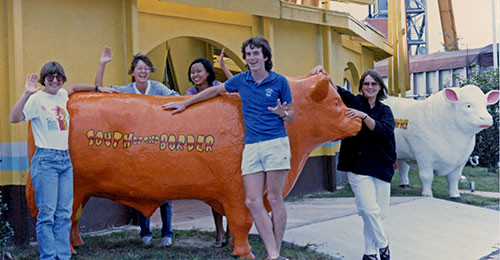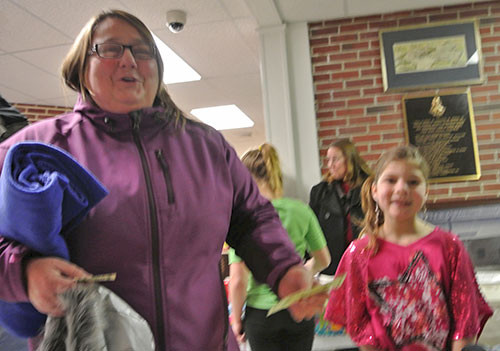Seagrasses and a little girl lost their greatest champion: Evamaria Koch (1961-2014)
Bill Dennison ·Evamaria Koch died last week from lung cancer. Lung cancer in non-smokers is particularly aggressive and Eva was not diagnosed until the disease had taken hold. She was very guarded about her condition, so most of her friends and colleagues were shocked to learn of her death. Eva was born to German parents in Brazil where she grew up and received her undergraduate training at the Universidad de Rio Grande. Eva obtained her graduate training at the University of South Florida (Masters and PhD) and followed that with a post doctorate at the Avery Point Laboratory, University of Connecticut. Eva joined the faculty at Horn Point Laboratory, University of Maryland Center for Environmental Science in 1995. Eva was multi-lingual, speaking fluent German, Portuguese and English. She was a conscientious practicing environmentalist and a rigorous experimental scientist.
Eva really loved seagrasses, the specialized marine flowering plants that grow in coastal waters throughout the world's oceans. She loved scuba diving and swimming through waving meadows of seagrasses. Eva loved talking about seagrasses, visiting seagrasses in different parts of the world and taking photos of seagrasses. Eva also loved studying seagrasses, analyzing seagrass data and reading and writing scientific papers about seagrass.
Eva was an active member of the Scientific and Technical Advisory Committee for the Maryland Coastal Bays Program. She was also an active member of the Submerged Aquatic Vegetation Workgroup in the Chesapeake Bay Program. Eva was one of the key contributors to the Submerged Aquatic Vegetation Technical Synthesis II, and helped set up the third technical synthesis which is about to begin. Her contribution in both Chincoteague and Chesapeake Bays was to provide a unique perspective to ecology by integrating physical processes like water motion and sediment characteristics.
One of the professional activities that Eva really enjoyed was her participation in the "Measuring ecological, economic and social values of coastal habitats to inform ecosystem-based management of land-sea" working group at the National Center for Ecological Analysis and Synthesis. Eva and her NCEAS colleagues traveled to Santa Barbara, California five times over several years and were able to publish some very highly cited synthetic scientific papers.
Eva was one of the founding members of the World Seagrass Association, which was formed at the fourth International Seagrass Biology Workshop in Corsica, France in 2000. She then served on the Steering Committee until her illness curtailed her efforts. Eva was a regular participant at the various International Seagrass Biology Workshops held around the world, as they allowed her the opportunity to learn more about seagrasses, interact with bright young students, and take field trips to visit seagrass meadows.

Eva gave interesting and informative scientific presentations. In the era of slide projectors, she would use two projectors simultaneously in a synchronized fashion. In the era of data
projectors, she combined her high quality underwater photographs with high quality data. Eva combined her grasp of the relevant physics with biology and ecology which, fueled with her passion for the subject, made her talks compelling. Eva taught in various graduate courses as part of the Marine-Estuarine-Environmental Sciences program and mentored various graduate students, research assistants and postdoctoral fellows.
I first met Eva when she was a graduate student in the laboratory of Clinton Dawes at the University of South Florida. Evi, as she was known, Penny Hall and Dave Tomasko formed a formidable team of seagrass graduate students who all went on to productive careers. They were 'thick as thieves' in graduate school and maintained their friendships until Eva's death. Mike Durako, a previous Dawes student, also became a long term colleague and friend.
I happened to be visiting Horn Point Laboratory in 1995 when Eva gave her job interview seminar. When she saw me, she told me that she was worried that I had returned from Australia to "take back my old job" since I had been at Horn Point until 1992. I assured her that I was at Horn Point to watch my wife Judy defend her dissertation, and that I would recommend to the Search Committee that they hire Eva and recommended to her to accept the position. Both things occurred and Eva spent the rest of her career at Horn Point.
I have two memories of Eva that illustrate the two enduring loves in her life, her daughter Olga and seagrasses. I have a nice memory of Eva when I ran into her and her daughter at the ice skating rink at our local community center. I had walked up to the rink and saw a little girl skating magnificently and said "Wow, that girl can really skate! Who is she?" I had not seen Eva sitting with the other parents until she chimed in, "That's my Oli". I looked at her with my eyebrows raised, and she positively beamed with motherly pride. We sat together and watched our daughters skate and she waxed eloquent about her Oli. Another nice memory of Eva was returning from a field trip from Chicoteague Bay. I had returned from ten years in Australia and Eva had invited me on a seagrass field trip. I rode with Eva while the research assistants and graduate student drove separately. Even though it was a long and chilly day in and on the water, Eva was very animated on the drive back to Easton. She was energized by scuba diving in seagrass meadows and she told me how much she loved field trips. Eva indicated that she couldn't imagine herself not being able to conduct field work in seagrass meadows.
Eva provided for her mother and her daughter right up until the end of her life and was reluctant to ask for help or accept offered assistance. Yet, Eva was very appreciative of the incredible support that she received from her brother, Walter and sister-in-law Claudia, her graduate student Dale Booth, Olga's teacher at Saints Peter and Paul Elementary School, Sherrie Connelly, her friends Larry and Alison Sanford, and the doctors and nurses at Johns Hopkins hospital.

Giuseppe DiCarlo, President of the World Seagrass Association (WSA), wrote a nice tribute, posted in the WSA facebook group. For those who knew Eva and would like to share their thoughts and memories, I recommend sharing these with Eva’s family and particularly for her daughter for when she is older and would like to remember her mother (Eva’s brother Walter’s email = wwkoch@hotmail.com). For those who would like to make a donation in her name for student travel scholarships for the International Seagrass Biology Workshops, her family has selected the World Seagrass Association.
About the author
Bill Dennison

Dr. Bill Dennison is a Professor of Marine Science and Vice President for Science Application at the University of Maryland Center for Environmental Science.
Next Post > A visit to New York Harbor School on Governors Island
Comments
-
Melissa 11 years ago
This was a beautiful write-up, Bill. I only knew Eva through video lectures of Biological Oceanography. I enjoyed her information and enthusiasm in the class. A great scientist.

